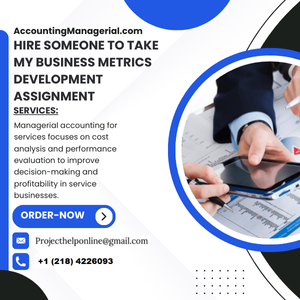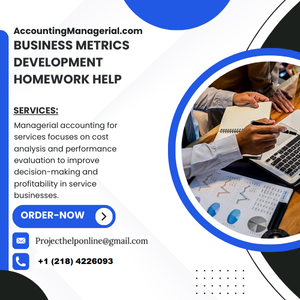Can someone help me interpret Business Metrics Development concepts for my homework?
Can someone help me interpret Business Metrics Development concepts for my homework? I don’t know how. I am a web
An effective introduction paragraph for an essay is key in engaging readers with its text and prompting them to read further. It should introduce and motivate the topic or question that your text will investigate as well as establish your position on that issue or question.
Management accounting requires practical thinking and practice, Business metrics development so the best way to learn its concepts is through hands-on examples from real life.
Variance analysis is an integral component of managerial accounting that quantifies how budget performance differs from actual results during any reporting period. By understanding why there is variance, businesses can improve financial oversight, forecasting, and planning for improved results. Businesses using variance analysis also benefit by being able to identify cost performance trends that need correction and quickly take corrective actions when necessary.
Variance analysis must take a holistic approach to business operations for it to be truly effective, which means combining accounting data with operational data in order to provide thorough explanations for any changes that occur in business operations. Furthermore, prioritizing variances ensures leadership is aware of any major business problems and can take appropriate actions.
NetSuite can deliver timely information that supports an active approach to budget management. Its unified data repository and integrated ERP capabilities make variance analysis faster, simpler and more effective; Costing you can even generate reports based on time period, account or variance type.
Understanding financial statements is a must for any business owner, as these documents offer a snapshot of a company’s health and performance. Financial statements also help business owners identify growth opportunities as well as risks. Furthermore, understanding trends over time helps management improve decision-making process.
Horizontal, vertical, and ratio analyses are three primary forms of financial statement analysis. Horizontal analysis involves identifying trends over time while vertical analysis compares lines items across a report. Ratio analysis uses line item data to calculate valuation metrics such as price-earnings ratios.
Financial statement analysis is an integral component of managerial accounting, Measuring Business Success used both internally and externally by stakeholders to assess business performance and value. Lenders will often utilize balance sheets and cash flow statements from companies they’re considering lending money to for creditworthiness assessments; similarly, suppliers use these reports as checks against late payments from a supplier.
Managerial accounting is an essential field of study that provides financial insights and analysis to aid decision-makers make informed choices. Due to its intricate nature and practical application of knowledge in real-life contexts, however, Data-Driven Metrics managerial accounting assignment help is frequently sought from professional service providers.

Cost behavior refers to the study of how business activities affect costs for an enterprise, providing managers with an invaluable tool in budget creation, cost-volume-profit analysis and cost control.
Understanding cost behavior can assist businesses in making more effective decisions regarding pricing, production, and resource allocation based on how costs change as activity levels change. For instance, companies selling bicycles may pay salaries to sales staff as well as a flat shipping rate per bike while another might only incur mileage costs for driving vehicles; such expenses are known as variable, step fixed, and mixed costs.
Management utilizes these patterns to develop a budget and project the future. This information can help determine the potential Effective KPI Tracking profitability of new projects or products lines as well as when to expand or contract its operations.
Business metrics provide quantifiable insight that contribute to a company’s success. Measurable insights help managers make more informed decisions; however, gathering and assessing this data can be time consuming; often necessitating sorting through emails or pestering coworkers for information you require.
Therefore, it’s necessary to formulate a strategy for collecting and analyzing business development metrics. The first step should be creating evaluation criteria which cover relevant, accuracy, measurability and alignment with goals of your firm. Tools or technologies available could include analytics platforms, CRM systems or tracking solutions; finally you should closely track results over time as this will allow you to continually improve performance over time and achieve goals set for yourself or improve overall company performance over time. These steps can help achieve objectives set for yourself or improve performance for any industry business.
Variance analysis is an essential component of managerial accounting, Business Metrics Framework helping businesses make sense of their financial results. This involves comparing actual performance with budgeted or standard results and explaining any variations between them – or disclosing why any do exist in any case.
Variance analysis allows businesses to quickly identify differences in sales, material costs, labor rates and overhead expenses between actual figures and expectations, creating flexible budget structures. It helps businesses set realistic expectations while meeting them on time.
Conducting effective variance analyses relies heavily on the quality of its data. To provide thorough and meaningful explanations, businesses need access to both operational and accounting information. In addition, conducting variance analysis can be resource intensive; automation tools may help streamline this process and ease resource burdens so as to provide more powerful insights to teams more quickly and effectively – such as marketing teams who struggle with budget variances needing more analytics and communication tools to get their results across effectively.
Financial statement analysis is an analytical practice designed to glean extra information from a business’s three principal financial statements – its balance sheet, Aligning Metrics with Strategy income statement and cash flow statement. By conducting such an examination of these documents, a company can develop a more complete and impartial picture of its profitability, value and creditworthiness.
Process Analysis Utilizing various analytical techniques – horizontal, vertical and ratio analyses are used – can reveal relationships among various data points on financial statements or across several statements issued during one period; as well as identify trends that would otherwise remain hidden.
Analysis can be conducted by numerous stakeholders, from internal managers and internal investors/lenders to potential investors and lenders. Evaluating one’s own performance is particularly essential for businesses as it can identify areas for improvement – potentially leading to operational changes or even complete restructures of its strategy.
Business metrics are quantifiable measures designed to track processes and evaluate Customer-Focused Metrics performance levels across different aspects of your business. Metrics play an essential role in setting company goals, tracking progress and rapidly adapting to changing conditions.
Key metrics will vary by business, but most commonly include sales revenue, profit margins and customer satisfaction.

Business metrics are quantitative measurements designed to track your company’s performance and progress toward its goals. You can use business metrics as tools for gauging the success of particular projects or campaigns as well as pinpoint areas for growth and improvement.
Establishing business metrics is a vital part of making informed decisions that promote growth and profitability. Selecting appropriate metrics as well as setting realistic targets and monitoring them regularly are all vital elements in creating success in business. By keeping an eye on business trends you will be able to respond promptly with necessary adjustments for sustained success.
To select the optimal business metrics for your company, Sales Performance Metrics begin by identifying its primary objectives and which metrics align with them. It is also important to evaluate whether the metrics you are tracking can be measured accurately and consistently over time. Once your metrics have been selected, collect historical data on them before calculating current values for comparison purposes. This will serve as a useful baseline against which future values may be judged against.
Business metrics provide organizations with an invaluable asset: they allow them to focus their energies on those issues which matter most for growth. To do this, organizations must identify goals and priorities before selecting metrics aligning with those goals that can be measured accurately and consistently. Finally, organizations should work on improving data operations and architecture so they can easily access any necessary information they require.
As an example, a startup company might choose to focus on revenue, cost of goods sold and gross profit margin as key financial indicators. They might also monitor net income – the remaining amount after subtracting operating expenses, taxes and other costs from total sales revenue – for additional insight. This metric can especially useful in measuring how quickly their business will become profitable.
Tracking business metrics is also an effective way for companies to identify emerging issues and take necessary corrective actions before they become more serious issues. They provide businesses with a means of communicating more efficiently with customers, Operational Efficiency Metrics shareholders and employees alike.
Business metrics are quantifiable measurements that measure progress towards specific goals or objectives within a company. They may pertain to operations, marketing, sales and customer experience metrics such as net promoter score (NPS) or customer effort score (CES).
Selecting the proper business metrics requires an understanding of your company’s goals and how they relate to customer value, then it becomes easier to identify those metrics critical for its success.
NPS is an invaluable metric for measuring customer loyalty and attachment levels, helping identify detractors, SMART Metrics for Business passives and promoters that you can target with customer experience strategies. Customer Experience Score (CES) measures how easy it is for customers to interact with your brand – everything from navigating your website to accessing support – using a straightforward question with three possible responses (Easy, None/Difficult). After subtracting out this percentage number of Difficult responses from all respondents for an aggregate score.
Business metrics serve as a compass, leading companies toward their desired goals and objectives. By understanding their importance, decoding their language, using their impactful decisions as guides for decision-making processes and effectively implementing them into decision making processes, businesses can gain a competitive edge in today’s ever-evolving business climate.
Employee performance metrics allow managers to track what’s working and not working within their teams and guide them toward success. Metrics like revenue per employee allow workers to gauge how their work contributes to boosting bottom lines.
Quality metrics provide an assessment of an employee’s work output. These may include objective measures like defects or subjective assessments like overall aesthetic value. For instance, Analytics for Business Growth an IT specialist’s performance may be assessed on whether they complete tasks quickly with minimal errors, as this metric ensures clients remain happy while business operations run efficiently.
Can someone help me interpret Business Metrics Development concepts for my homework? I don’t know how. I am a web
What are the risks of hiring someone for Business Metrics Development homework assistance? Hi, My name is Dierking-Heng, and I
How do I prevent mistakes when hiring someone to do my Business Metrics Development homework? is my job depends on
Can I get a discount for multiple Business Metrics Development homework assignments? IN THE LIBRARY:The book is not my favorite.
Can I get professional help with Business Metrics Development homework for a business course? I thought about it before but
Are there any tutors who offer live chat for Business Metrics Development homework help? The following offer is for the
Can I pay someone for Business Metrics Development homework help even if it’s an urgent assignment? You want to know
What happens if the person I hire for Business Metrics Development homework doesn’t meet my expectations? Does the person want
Is it safe to share my personal information when paying for Business Metrics Development homework? I just did a Business
Can I get Business Metrics Development homework help in multiple languages? Hello again. I have no idea how to translate
Accounting managerial for services involves analyzing financial data to assist service-based businesses in planning, decision-making, and optimizing resource allocation.

![]()

Copyright © All rights reserved |Accounting Managerial